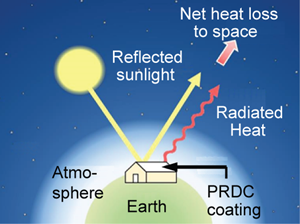Crossref Citations
This article has been cited by the following publications. This list is generated based on data provided by
Crossref.
Chen, Jianheng
and
Lu, Lin
2020.
Development of radiative cooling and its integration with buildings: A comprehensive review.
Solar Energy,
Vol. 212,
Issue. ,
p.
125.
Huang, Wenlong
Chen, Yijun
Luo, Yu
Mandal, Jyotirmoy
Li, Wenxi
Chen, Meijie
Tsai, Cheng‐Chia
Shan, Zhongqiang
Yu, Nanfang
and
Yang, Yuan
2021.
Scalable Aqueous Processing‐Based Passive Daytime Radiative Cooling Coatings.
Advanced Functional Materials,
Vol. 31,
Issue. 19,
Yang, Zhangbin
Zhou, Zichen
Sun, Haoxuan
Chen, Tingting
and
Zhang, Jun
2021.
Construction of a ternary channel efficient passive cooling composites with solar-reflective, thermoemissive, and thermoconductive properties.
Composites Science and Technology,
Vol. 207,
Issue. ,
p.
108743.
Yang, Zhangbin
and
Zhang, Jun
2021.
Bioinspired Radiative Cooling Structure with Randomly Stacked Fibers for Efficient All-Day Passive Cooling.
ACS Applied Materials & Interfaces,
Vol. 13,
Issue. 36,
p.
43387.
Zhong, Hongmei
Li, Yanan
Zhang, Peng
Gao, Shouwei
Liu, Bingying
Wang, Yang
Meng, Ting
Zhou, Yongsen
Hou, Huwang
Xue, Chaohua
Zhao, Yang
and
Wang, Zuankai
2021.
Hierarchically Hollow Microfibers as a Scalable and Effective Thermal Insulating Cooler for Buildings.
ACS Nano,
Vol. 15,
Issue. 6,
p.
10076.
Khan, Ansar
Carlosena, Laura
Khorat, Samiran
Khatun, Rupali
Doan, Quang-Van
Feng, Jie
and
Santamouris, Mattheos
2021.
On the winter overcooling penalty of super cool photonic materials in cities.
Solar Energy Advances,
Vol. 1,
Issue. ,
p.
100009.
Sinsel, Tim
Simon, Helge
Broadbent, Ashley M.
Bruse, Michael
and
Heusinger, Jannik
2021.
Modeling impacts of super cool roofs on air temperature at pedestrian level in mesoscale and microscale climate models.
Urban Climate,
Vol. 40,
Issue. ,
p.
101001.
Yu, Xinxian
Chan, Jiaqi
and
Chen, Chun
2021.
Review of radiative cooling materials: Performance evaluation and design approaches.
Nano Energy,
Vol. 88,
Issue. ,
p.
106259.
Chen, Meijie
Pang, Dan
Mandal, Jyotirmoy
Chen, Xingyu
Yan, Hongjie
He, Yurong
Yu, Nanfang
and
Yang, Yuan
2021.
Designing Mesoporous Photonic Structures for High-Performance Passive Daytime Radiative Cooling.
Nano Letters,
Vol. 21,
Issue. 3,
p.
1412.
Meddeb, Hosni
Götz‐Köhler, Maximilian
Neugebohrn, Nils
Banik, Udayan
Osterthun, Norbert
Sergeev, Oleg
Berends, Dennis
Lattyak, Colleen
Gehrke, Kai
and
Vehse, Martin
2022.
Tunable Photovoltaics: Adapting Solar Cell Technologies to Versatile Applications.
Advanced Energy Materials,
Vol. 12,
Issue. 28,
Chen, Meijie
Pang, Dan
Chen, Xingyu
Yan, Hongjie
and
Yang, Yuan
2022.
Passive daytime radiative cooling: Fundamentals, material designs, and applications.
EcoMat,
Vol. 4,
Issue. 1,
Yang, Zhangbin
Jia, Yu
and
Zhang, Jun
2022.
Hierarchical-Morphology Metal/Polymer Heterostructure for Scalable Multimodal Thermal Management.
ACS Applied Materials & Interfaces,
Vol. 14,
Issue. 21,
p.
24755.
Chen, Meijie
Pang, Dan
and
Yan, Hongjie
2022.
Sustainable and self-cleaning bilayer coatings for high-efficiency daytime radiative cooling.
Journal of Materials Chemistry C,
Vol. 10,
Issue. 21,
p.
8329.
Zhao, Yanwei
Pang, Dan
Chen, Meijie
Chen, Zhuo
and
Yan, Hongjie
2022.
Scalable aqueous processing-based radiative cooling coatings for heat dissipation applications.
Applied Materials Today,
Vol. 26,
Issue. ,
p.
101298.
Du, Mu
Huang, Maoquan
Yu, Xiyu
Ren, Xingjie
and
Sun, Qie
2022.
Structure Design of Polymer-Based Films for Passive Daytime Radiative Cooling.
Micromachines,
Vol. 13,
Issue. 12,
p.
2137.
Yao, Pengcheng
Chen, Zipeng
Liu, Tianji
Liao, Xiangbiao
Yang, Zhengwei
Li, Jinlei
Jiang, Yi
Xu, Ning
Li, Wei
Zhu, Bin
and
Zhu, Jia
2022.
Spider‐Silk‐Inspired Nanocomposite Polymers for Durable Daytime Radiative Cooling.
Advanced Materials,
Vol. 34,
Issue. 51,
Lv, Song
Ji, Yishuang
Ji, Yitong
Qian, Zuoqin
Ren, Juwen
Zhang, Bolong
Lai, Yin
Yang, Jiahao
and
Chang, Zhihao
2022.
Experimental and numerical comparative investigation on 24h radiative cooling performance of a simple organic composite film.
Energy,
Vol. 261,
Issue. ,
p.
125140.
Chen, Meijie
Pang, Dan
and
Yan, Hongjie
2022.
Highly solar reflectance and infrared transparent porous coating for non-contact heat dissipations.
iScience,
Vol. 25,
Issue. 8,
p.
104726.
Ni, Nan
Qie, Boyu
Du, Sicen
Sang, Zhe
Wang, Qiushi
Meng, Changgong
and
Tong, Yexiang
2022.
A novel all-solid-state S-scheme in CdS/ZnTHPP binary nanosystem for hydrogen evolution.
International Journal of Hydrogen Energy,
Vol. 47,
Issue. 26,
p.
13044.
Yu, Haiyan
Zhang, Haochun
Zhao, Jinchuan
Liu, Jing
Xia, Xinlin
and
Wu, Xiaohu
2022.
Thermal conductivity of micro/nano-porous polymers: Prediction models and applications.
Frontiers of Physics,
Vol. 17,
Issue. 2,





